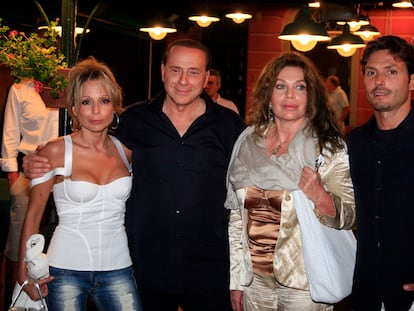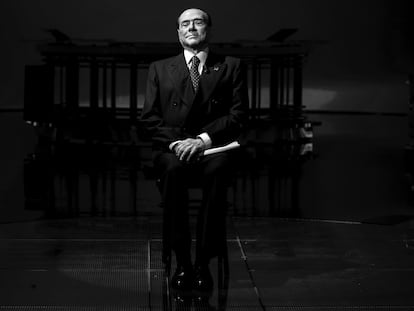Murder, millions and ‘moral masochism’: The long and gruesome history of Berlusconi’s Villa San Martino
The former Italian prime minister’s residence, where his body lay before his state funeral, has a dark past after the ‘crime that shocked Italy’ 50 years ago
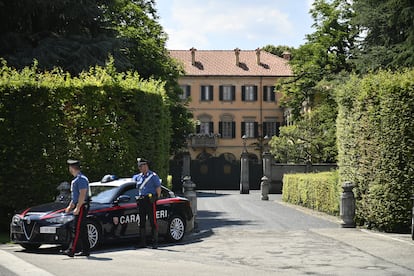
On August 30, 1970 a terrible crime shocked the traditionally reserved and puritanical Roman society. In a duplex in Via Puccini in the center of Rome, three people were found dead from gunshot wounds. Marquis Camillo Casati Stampa, his wife, Anna Casati, 41, and Massimo Minorenti, 25. The marquis belonged to one of the richest families in northern Italy and owned land and properties in the Milan area. Among these was Villa San Martino, in Arcore, a beautiful 90-hectare estate featuring a superb 18th-century palace, which in 1974 became Silvio Berlusconi’s residence and headquarters and where his mortal remains rested until his state funeral was held on June 14.
A huge deception
The marquis also had a daughter from a previous marriage, Anna Maria Casati, who despite becoming his universal heir did not have access to her inheritance because she was a minor at the time of the crimes. The management of her estate fell to two guardians: Giorgio Bergamasco and a young and ambitious lawyer, Césare Previti, although it was the latter who would take care of Anna Maria’s affairs because Bergamasco was soon appointed a minister in Giulio Andreotti’s government.
When in 1972 Anna Maria turned 21, she decided to put her father’s properties up for sale. Later, she moved to Brazil. Obeying Anna Maria’s wishes, Previti got down to work and soon relayed two pieces of news, one good and one bad. The good news was that Villa San Martino had a buyer. The bad news was that he was only willing to pay 500 million lire (about $280,000) in the form of shares in the buyer’s construction company. The buyer’s name was Silvio Berlusconi. Previti advised her to sell; Anna Maria trusted his advice.

Villa San Martino and everything in it — a library with thousands of volumes, furniture and works of art of great value — passed into the hands of the young Berlusconi and Anna Maria was given a handful of shares which, she was assured, were valued at 1.7 billion lire. When later, from Brazil, Anna Maria decided to sell them, only one buyer emerged: Berlusconi, who took them back at half price. Today, San Martino is valued at close to $57 million.
Anna Maria still lives abroad with her family. She has never returned to Italy and wants nothing to do with this story. Previti made his fortune glued to Berlusconi: he was his right-hand man in business, became Minister of Defense in Berlusconi’s first government and a parliamentarian with Forza Italia. He also served as Il Cavaliere’s lawyer. After a scandal-ridden career, in 2006 he was imprisoned for bribing judges.
A bloody prologue
Marquis Camillo Casati Stampa was a tall, dark man, a seasoned hunter, and a great horseman. But, above all, he was extremely rich. The Casati Stampa were a noble Lombard family and Camillo Casati Stampa di Soncino had inherited a tract of land in Segrate, as well as luxury buildings and apartments in Rome and Milan, hunting estates and a castle in Cusago. He also owned the island of Zannone, a small piece of wilderness in the Tyrrhenian Sea, between Rome and Naples, which included a mansion. It was an uninhibited and uninhabited environment where only one man reigned: the marquis.
Camillo married the Neapolitan dancer Letizia Izzo, whose stage name was Lidia Holdt, and had a daughter, Anna Maria, but when he met Anna Fallarino, his world was turned upside down. Fallarino was a beautiful, dark-haired young woman, the daughter of a clerk and a housewife, who had left her native Benevento, in central Italy, to seek her fortune. Her intention was to carve out a career as an actress in Rome, but she did not have the same luck of other Italian legends from humble origins such as Sofia Loren, and the only film in which she appeared, Totò Tarzan (1950), did not serve as a launchpad.
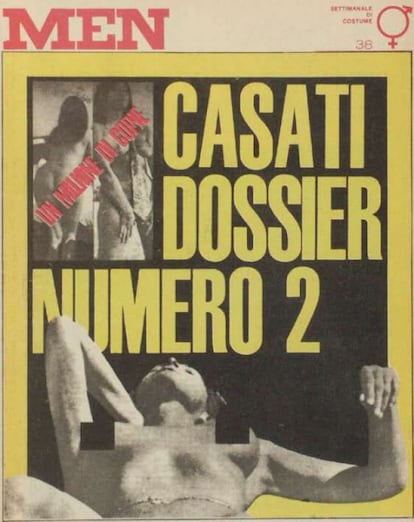
Her luck changed when she met Giuseppe “Peppino” Drommi, a wealthy and generous 28-year-old engineer, who married her. Fallarino began to frequent parties and events, and in 1958, in Cannes, she met the famous Dominican playboy Porfirio Rubirosa, who fell in love with her and tried to seduce her. Peppino, offended, confronted Rubirosa and Camillo Stampa, who was also present at the party, tried to calm the two men down. It was then that the lives of Camillo and Anna crossed for the first time, and the marquis was smitten. The feeling was mutual. Camillo and Anna fell madly in love and, after having their respective marriages annulled, thanks to the Marquis’ influence and after shelling out a significant amount of money, they married in 1959.
“This was not part of the game”
Thus began a strange relationship. On the couple’s wedding night, the marquis asked his wife to have sex with a waiter in front of him. Everything was recorded in the marquis’ diary, which was leaked to the press (some believe by the police), and excerpts of which were published in several newspapers at the time. Of his honeymoon he wrote: “Anna has been splendid. She understood right away. She had a lot of fun.” Having sex with handsome young men while Casati Stampa watched, took pictures, and wrote things down in a green velvet-lined notebook became a regular practice for the couple. Usually, it was the marquis who chose Anna’s lovers, who were usually young, handsome and of lower social classes. Sometimes they would search together outside bars. “Today Anna gave me great pleasure. She made love to a young soldier in such an effective way that from afar I have participated in the act. It cost me 30,000 lire, but it was worth it,” read one entry.
They became the fashionable couple. “They were invited to all the parties; they were part of the hunting circle, they played bridge...” said Daniele Protti, director of the now defunct weekly news magazine L’Europeo, in a documentary on the Italian History channel. They also organized parties and hunts at their own properties, one of them Zannone, an island that was not worth much but where the marquis could devote himself to his hobby, hunting, and the marquise consort to hers, sunbathing naked. Salvatore Pagano, who died in 2021 at the age of 86, was for many years the guardian of the island. “My uncle would talk to us about important guests and particular situations. He transported food to the villa with three donkeys. The marquise was provocative, but she respected the marquis and kept her place,” he told La Repubblica.
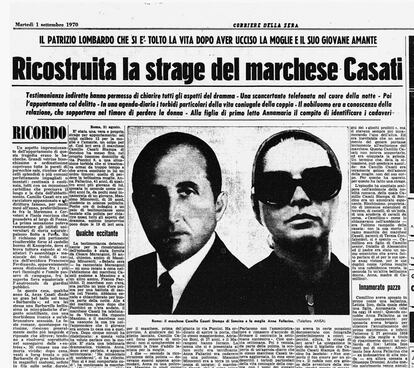
However, everything changed in January 1970 when Anna Fallarino met Massimo Minorenti, a 25-year-old leader of the Fascist youth. What began as a sexual encounter, as on other occasions, turned into something more. Anna and Massimo felt a mutual attraction and fell in love. The marquis noted in his diary: “This was not part of the game. This is the first time my wife has ever cheated on me with her heart.” One day in August of that year the marquis, who had gone hunting at the Marzotto family estate in Valdagno, phoned his wife and Minorenti answered the phone. Shortly afterwards, he returned to his Rome duplex and asked his staff not to disturb him. He wrote in his diary: “Amore mio, forgive me, but what I will do, I must do. Farewell, the only joy of my life.”
It would be the last entry in his diary. The marquis took one of his shotguns and discharged six 12-gauge shots: two for Minorenti, three for his love, Anna Fallarino, and the last for himself.
“Moral masochism”
It became known as “the crime that shocked Italy” and the press had a field day. Up to 1,500 nude photos of Fallarino were published. A major newspaper even offered 400,000 lire for 12 images, almost the price for which Berlusconi would later buy Villa San Martino. MEN magazine sold a million copies with provocative photos of Anna Fallarino on the cover. The crime gave rise to all kinds of questions and theories. Interviewed by L’Europeo, psychoanalyst Emilio Servadio tried to shed some light on the behavior of the marquis: “This man not only enjoyed his wife having sex, but he photographed it, filmed it, demanded it and promoted it at every opportunity.”
Servadio conducted a psychological profile of Casati and concluded that he was voyeuristic, sadomasochistic, and probably had homosexual tendencies. “Without realizing it, the individual projects his feminine component onto the woman, and the encounter becomes truly homosexual. It also has a strong sadomasochistic component. In their inner self, they present themselves as victims of a situation: they are betrayed husbands. Casati was not one of those men who like to be whipped or beaten, but what he practiced I would call moral masochism.” More than 50 years later, following Berlusconi’s death, the crime has been back in the news without losing any of its power of fascination. “The fortune of this residence was born from a tragedy,” Il Giorno stated a few days ago. For now, this seems to be its final act.
Sign up for our weekly newsletter to get more English-language news coverage from EL PAÍS USA Edition
Tu suscripción se está usando en otro dispositivo
¿Quieres añadir otro usuario a tu suscripción?
Si continúas leyendo en este dispositivo, no se podrá leer en el otro.
FlechaTu suscripción se está usando en otro dispositivo y solo puedes acceder a EL PAÍS desde un dispositivo a la vez.
Si quieres compartir tu cuenta, cambia tu suscripción a la modalidad Premium, así podrás añadir otro usuario. Cada uno accederá con su propia cuenta de email, lo que os permitirá personalizar vuestra experiencia en EL PAÍS.
¿Tienes una suscripción de empresa? Accede aquí para contratar más cuentas.
En el caso de no saber quién está usando tu cuenta, te recomendamos cambiar tu contraseña aquí.
Si decides continuar compartiendo tu cuenta, este mensaje se mostrará en tu dispositivo y en el de la otra persona que está usando tu cuenta de forma indefinida, afectando a tu experiencia de lectura. Puedes consultar aquí los términos y condiciones de la suscripción digital.
More information
Archived In
Últimas noticias
Mexico seeks to shore up its defenses following US incursion in Venezuela
Hope gives way to uncertainty among Venezuelan exiles in the US after Maduro’s capture
Cubans look to Venezuela fearfully after Trump’s incursion: ‘We could be next’
The operation in Venezuela to capture Maduro threatens to widen the cracks in the MAGA movement
Most viewed
- Alain Aspect, Nobel laureate in physics: ‘Einstein was so smart that he would have had to recognize quantum entanglement’
- Gilles Lipovetsky: ‘If you want to live better and fall in love, take Prozac, don’t look to philosophy’
- Alvin Hellerstein, a 92-year-old judge appointed by Bill Clinton, to preside over Maduro’s trial in New York
- Cuba confirms death of 32 of its citizens in the US attack against Venezuela
- Why oil has been at the center of Venezuela-US conflicts for decades
